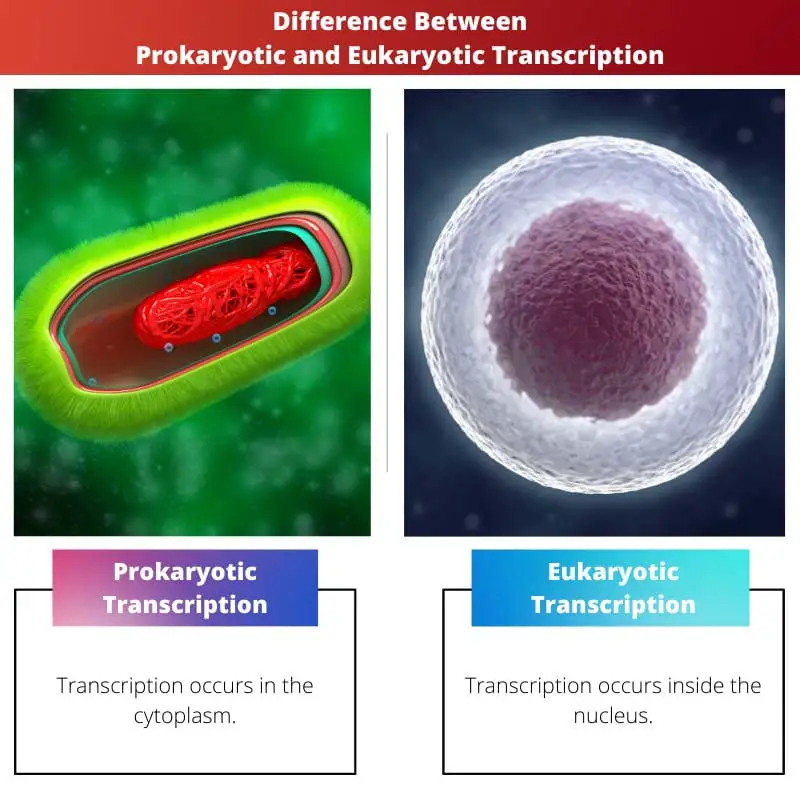Chromosomes are long molecules that contain millions of base pairs, making up a single chromosome. Most of these are special; they are known as genes.
Key Takeaways
- Prokaryotic transcription occurs in the cytoplasm, while Eukaryotic transcription occurs in the nucleus.
- Prokaryotic transcription involves a single RNA polymerase enzyme, while Eukaryotic transcription involves three different RNA polymerases.
- Prokaryotic transcription does not require any post-transcriptional modification, whereas Eukaryotic transcription requires extensive post-transcriptional modification.
Prokaryotic vs Eukaryotic Transcription
The difference between prokaryotic transcription and eukaryotic transcription is that the prokaryotic transcription process occurs in the cytoplasm, while the eukaryotic transcription process occurs in the nucleus. The prokaryotic is the simple stage where there is DNA that is transcribed in RNA, which is fully functional and is translated into proteins, whereas in eukaryotes, the first RNA that is produced is called premature RNA, which doesn’t have the capability of making proteins then and there so, So there are modifications called splicing, 5 major end caps, and 3 major extensions.

In prokaryotic transcription and translation, both occur at the same time, so there is a small amount of mRNA processing.
In eukaryotic transcription, there is extensive mRNA processing, that is, the removal of introns and the addition of exons, the addition of 5 caps, and the addition of poly-a tails.
Comparison Table
| Parameters of Comparison | Prokaryotic Transcription | Eukaryotic Transcription |
|---|---|---|
| Site of Transcription | Transcription occurs in the cytoplasm. | Transcription occurs inside the nucleus. |
| Translation Association | Coupled transcription and translation. | Coupled transcription and translation are not possible. |
| RNA Polymerase | A single RNA polymerase synthesizes all types of RNA. | Three types of RNA polymerase. |
| Initiation | Generally, no proteins are required. | It requires proteins called transcription factors. |
| Transcriptional unit | Polycistronic | Monocistronic |
What is Prokaryotic Transcription?
Prokaryotic transcription involves several genes, resulting in polycistronic mRNAs that specify multiple proteins in a single molecule.
The prokaryotic transcription proceeds in three steps- Initiation, Elongation, and Termination. And this process is driven by the DNA-dependent RNA polymerase enzyme, which transcribes the DNA.
Two promoter consensus sequences are located in the -10 and -35 regions upstream of the start site, which is the same in all promoters and bacterial species.
Polymerase aborts when it is unable to synthesize. Once polymerase is synthesized, i.e., threshold 10+ nucleotides are synthesized, that’s called successful initiation.
What is Eukaryotic Transcription?
The transcription of eukaryotes is much more complicated than that of prokaryotes. In contrast to bacterial RNA polymerase, it can form a connection with the DNA template on its own.
The Eukaryotes have 3 RNA polymerase enzymes. RNA polymerase 2 is a major polymerase enzyme involved in the transcription of mRNA in eukaryotes.
The DNA strands and the nascent RNA chain exit via separate channels; the two DNA strands reunite at the transcription bubble’s trailing end, while the single-strand RNA exits on its own at the transcription bubble’s leading end.
Main Differences Between Prokaryotic and Eukaryotic Transcription
- In prokaryotic, no proteins are required, whereas eukaryotic transcription requires proteins called transcription factors.
- The prokaryotic transcriptional unit is polycistronic, whereas, in eukaryotic transcription, it is monocistronic.

- https://www.nature.com/articles/nature14447
- https://www.sciencedirect.com/science/article/pii/S0969212601007031